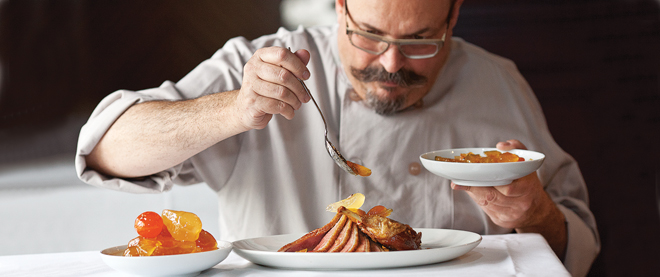Chefs have the hots for mostarda
The nasal-clearing condiment from Cremona is finally being imported to Canada
Photograph by Andrew Tolson
Share

Just as the bone-chilling season arrives, an effective antidote to cold, dark days is set to appear in select shops in Canada. Mostarda di Cremona is a singular condiment, a perfect fusion of candied whole fruit, amber syrup and a wallop of nasal-clearing essential oil made from mustard seeds. Dating to Roman times, it’s a seasonal chutney from a small city in Italy’s Po Valley where the need to preserve fruit during unyielding months of damp cold inspired its creation.
You might have encountered it here, paired with a plate of charcuterie or assorted cheeses, at a handful of fine restaurants such as Cioppino’s in Vancouver, where chef Pino Posteraro calls it “a unique, wonderful thing.” The sour-sweet confection, traditionally served alongside rib-sticking fare such as a fragrant dish of boiled meats known as bollito misto, is also a match for other rich dishes. Posteraro uses it to garnish a dish of headcheese made from Saltspring Island pork and cured in-house. He also favours it with fresh cheese, “like a nice Camembert goat,” and says it pairs well with a good glass of sparkling wine.
Mostarda is a specialty of the Lombardy region and varies from town to town. There’s one made of quince, another with pumpkin for stuffing ravioli and one made of vegetables only. Some have only a hint of spice, even though all are preserved with the oil made by grinding mustard seeds, then diluting the extraction and distilling it with steam. This creates a powerful compound called allyl isothiocyanate, which is so strong it can irritate skin and mucous membranes. For this reason, essential mustard oil is only sold in pharmacies in Italy.
Some bland, sweet versions of mostarda have been available in Canada for years, but these don’t compare to the finely crafted hot stuff. Just ask Massimo Capra, a native of Cremona, the owner of Toronto’s Mistura restaurant and chef at the Crowne Plaza Hotel’s Rainbow Room in Niagara Falls, Ont. “My mother bought the sweet stuff and I didn’t like it. But once I tasted the spicy mostarda, I had a moment. Everything changed.”
Unable to live without it, Capra has been importing fiery mostarda for his restaurants from his favourite producer, Fieschi. He also adds tiny doses of essential mustard oil to take it up a notch and serves it to diners. “It’s got to have that wasabi feel. And the Canadian palate is used to different cuisines, so we also like it spicier.”
And now he has persuaded Michael Tkaczuk of Toronto-based Catch Fine Foods to bring in the same brand for home cooks and restaurants. Tkaczuk, the first to import Ibérico and serrano hams from Spain, has an eye for trendy products. But until he tasted the mostarda from Fieschi, a purveyor, candymaker and shop based in Cremona, he wasn’t sure it would fly. “You’re dealing with something that’s unusual. Some will love it while others might find it, well, strange.” You can buy it in a handful of fine food stores such as the Italian Centre Shop in Edmonton and Ottawa’s La Bottega Nicastro, in small and large jars that sell for $17 to $27.
Purists be damned, there is a DIY mostarda movement, and Mario Batali is in on it. These rebels claim you can create satisfactory results at home by adding dried mustard or hot mustard to candied or dried fruits, but Capra disagrees. “Some chefs don’t understand the mustard oil. It’s super powerful but not greasy. It’s really an essence.”
And as easy as it is to preserve fruit in syrup, Tkaczuk says it’s not that simple: “There’s the bite of the mustard oil, the firmness of the fruit and the syrup—not too sugary—that create a balance.”
Although the designations of origin of other Italian specialties such as parmigiano reggiano, Parma prosciutto and Neapolitan pizza are protected by laws, mostarda di Cremona has no regional designation. But Capra feels so strongly about the Fieschi mostarda that he is going to use it as a launching point for a “Capra-approved” line of Italian food. “There are other ideas in the pipeline,” says Tkaczuk, who refuses to elaborate. “For now we’ve got our hands full with mostarda and just explaining what it is.”